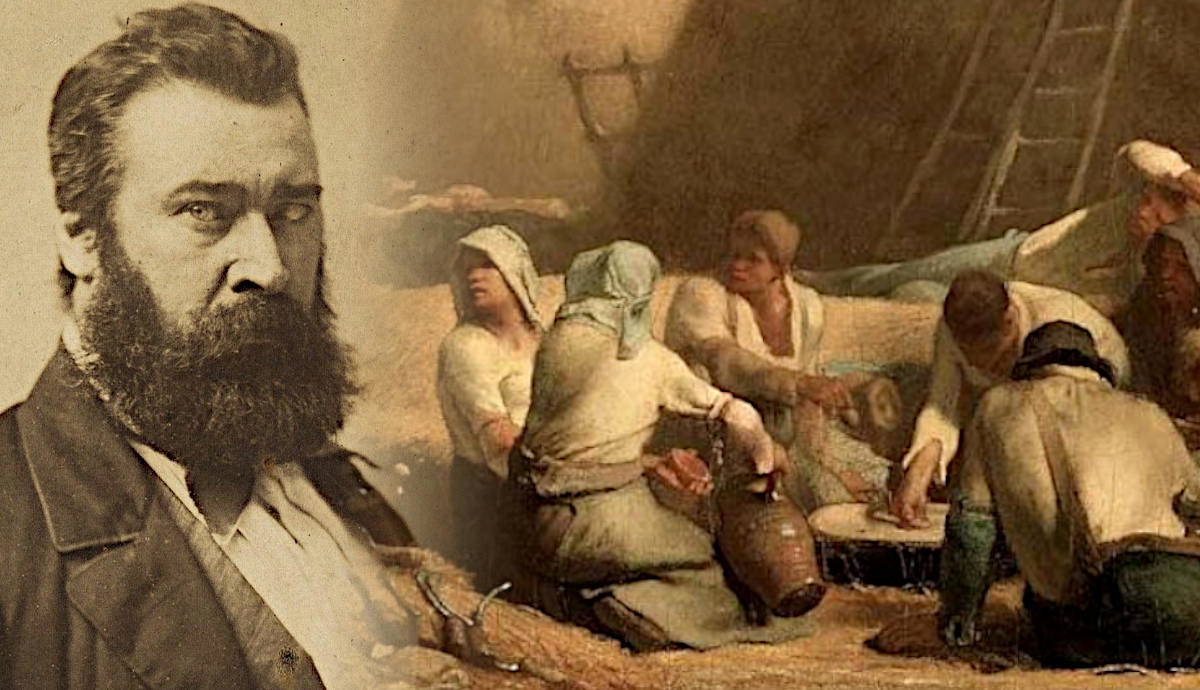French painter Jean-Francois Millet was one of the founding members of the Barbizon school and is most well-known for his work in naturalism and realism with his peasant subject matter at the forefront of his art. Learn more about this prolific artist with these five interesting facts.
1. Millet’s Work Focused Predominantly on Peasants.
Millet was born to a family of farmers in the village of Gruchy in Normandy. As a young boy, he farmed the land with his father. It wasn’t until he was 19 years old that he left farm work to study art.
Class divisions were a big deal in the 1800s, Millet saw the peasant-class as the noblest class and thought they were fulfilling the words of the Bible more so than other classes of the time.
These peasants would become the center of his art throughout his career and for which he would become known and remembered for.
Perhaps also influenced by the bloody French Revolution in which working-class Frenchmen rose up against the monarchy, Millet depicted peasants toiling in the fields in the same way that religious figures and mythological creatures would have been paintings beforehand.
2. At First, Millet’s Paintings Were Rejected for the Salon.
Get the latest articles delivered to your inbox
Sign up to our Free Weekly Newsletter
Millet studied art a bit later than some of his contemporaries due to spending his youth as a farmer. In 1837, he enrolled at the studio of Paul Delaroche in Paris. A rejection from the 1840 Salon dampened his spirits and he moved back to Cherbourg.
He achieved his first bit of success a few years later with Norman Milkmaid and The Riding Lesson and then eventually earned a spot at the Salon with The Winnower which was unveiled in 1848. Unfortunately, the piece was lost in a fire and the 1850s proved to be a time of hardship for Millet. He moved again to live in Barbizon and continued to paint his peasants there.
By the mid-1860s, Millet’s paintings were being noticed once again and nine of them were exhibited. Important pieces from this collection now live at the Museum of Fine Arts in Boston and the Louvre in Paris.
3. His Art Was Important to the Naturalist and Realist Movements
Naturalism is a style represented by the accurate depiction of detail. Realism, similarly, is the style that represents a person or thing in a way that’s accurate and true to life. Millet painted in a way that was true to life while maintaining an artistic quality that evoked emotion and honored his skill.
In staying with his subject matter of peasants and their lives, Millet’s first success at the Salon came in 1847 with Oedipus Take Down from the Tree. A year later, success continued as the state purchased The Winnower before offering him a commission in 1849 which became Harvesters.
In the Salon of 1850, he exhibited Haymakers and The Sower. The Sower became his first major masterpiece and the first of his most iconic trio that included The Gleaners and The Angelus.
By depicting real people doing real things without abstraction, grandiose, or mythological pretense, Millet became a major influence in the realms of naturalism and realism, going on to influence countless other artists in the future.
4. Millet Only Dated One of His Pieces.
For reasons unknown, Millet only ever dated one of his paintings, Harvesters Resting, which took three years to complete, 1850-1853. This work would be considered as his most important. It marked a shift from symbolic imagery of the peasants he so admired and transitioned to a sort of commentary on their contemporary social conditions.
Harvesters Resting was also the first painting in which Millet earned official recognition by winning the second-class medal at the 1853 Salon.
5. Millet Inspired Modern Artists, Including Vincent Van Gogh
It should come as no surprise that Millet’s legacy would live on through the work of artists who came after him. Between his landscape technique, symbolic content, and his life as an artist inspired various modern artworks from some of the biggest names to ever appear on the scene.
Vincent Van Gogh was particularly influenced by Millet, especially early in his career, mentioning him often in Van Gogh’s letter to his brother Theo.
Claude Monet, who also specialized in landscapes took references from Millet’s work and the structural contents of Millet’s compositions would influence Georges Seurat as well.
Mark Twain wrote a play called “Is He Dead?” which followed the life of a struggling artist who faked his own death to receive fame and fortune. The character was named Millet and although the play was fictional, he took some details from the real Millet’s actual life.
L’homme a la houe painted by Millet was the inspiration for a poem by Edwin Markham called “The Man with the Hoe” and The Angelus has been reprinted in huge numbers throughout the 19th and 20th centuries.
L’angelus by Jean-Francois Millet, 1857-59, via Musée d’Orsay, Paris
Perhaps most interestingly, Salvador Dali was infatuated by Millet’s work. He even wrote a fascinating analysis on The Angelus called “The Myth of the Angelus of Millet”. Dali argued that the two figures in the painted weren’t praying to Angelus at all. He said they were praying over their buried child.
Dali was insistent in his correctness to the point where an X-ray was taken of the canvas. It was enough for Dali to confirm his suspicious because the painting does contain a painted-over shape that resembles a coffin. Still, Millet’s actual intentions remain unclear.
As you can see, Millet’s legacy is prolific and long-lasting. He not only influenced other painters but artists of all kinds with his compositions and style – all with a focus on hardworking peasants.

